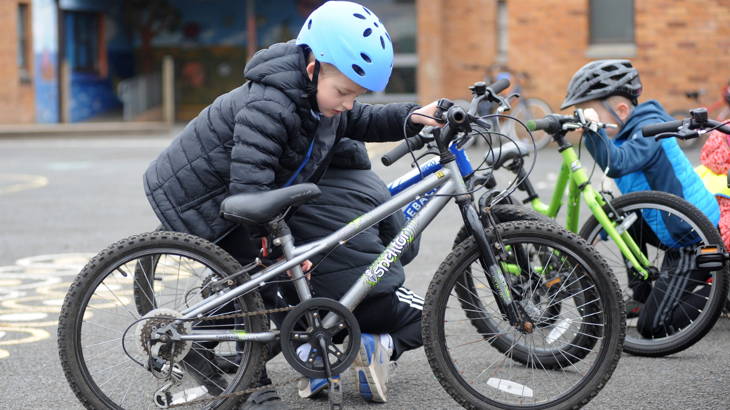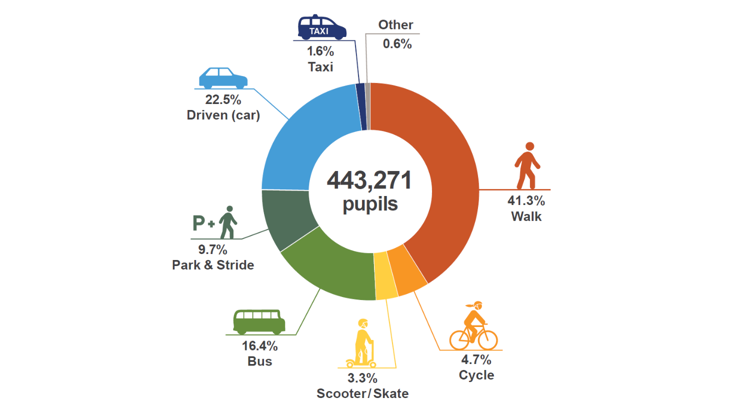The Hands Up Scotland Survey results provide a valuable annual snapshot of how pupils travel to school and nursery. Our Head of Behaviour Change in Scotland, Dr Cecilia Oram, delves into this year’s results and what they mean for young people and schools in Scotland.

The Hands Up Scotland Survey gives insight into how pupils travel to school. Cycling is at its highest level since the survey started. Credit: Jim McEwan/Sustrans
The Hands Up Scotland Survey examines how pupils travel to school - whether by foot, cycle, scooter or skating, park and stride, car, bus, taxi or other.
Over one week in September, nursery children and primary and secondary school pupils are asked a question: “How do you normally travel to school?”
Every year the findings paint a compelling picture and this time it is no different.
Driving down as cycling, scootering and skating rise
Figures from the survey show that the proportion of pupils being driven to school dropped to 22.5% in 2023, the lowest level recorded since 2016.
On the other side of the coin, 4.7% of pupils cycled to school in 2023 – the highest level recorded since the survey began.
This indicates that the trend of cycling to school is on the rise, following an increase from 3.4% in 2014.
Walking to school declined marginally compared to the previous year. However, it remains the most common mode of transport by far, standing at 41.3%.
Meanwhile, travelling to school by bus reached its highest level since 2017 with 16.4% of pupils saying they now travel in this way.
This suggests an upward trend as bus use has increased for a third year in a row.
Alongside this, scootering and skating also jumped to a record high of 3.3% in 2023.

According to the results, driving has reached its lowest level since 2016. Meanwhile, cycling, scootering and skating are seeing an upward trend.
What do the findings mean for schools and pupils?
While the survey results can be influenced by wider events, most notably the Coronavirus pandemic, they provide a valuable insight into active and sustainable travel.
The sustained upward trend of bus use may suggest the free bus travel for under 22s initiative is continuing to have a positive impact.
Given the rise in bus travel amongst young people, it’s important to ensure they can safely and easily access public transport by foot, wheelchair or other mobility aid.
While active travel has seen a marginal drop overall since last year, influenced by a slight decrease in walking, it is encouraging to see that it remains higher than pre-pandemic levels.
The jump in cycling to the highest level ever recorded by the survey is certainly worth celebrating.
However, the notable gap between the levels of cycling in primary schools (6.6%) compared to secondary schools (1.4%) presents an opportunity to encourage more teenagers to cycle.
If we are to normalise walking and cycling to school, we need to build safe cycling and walking infrastructure for all local school journeys.
For example, the new Easter Carmuirs Pocket Places, supported by Sustrans Scotland, features a wider pedestrian walkway and the installation of ramps so the pupils of Easter Carmuirs Primary School can more easily walk, wheel or cycle to school.

Each September, schools across Scotland complete the survey by asking their pupils ‘How do you normally travel to school?’.
Background
Established in 2008, the Hands Up Scotland Survey is important for policy making on transport issues within Scotland.
The survey is the largest national dataset on school travel, becoming an official statistic in 2012.
The Hands Up Scotland Survey is funded by the Scottish Government through Transport Scotland and is a joint survey between Sustrans and all 32 Scottish local authorities.





